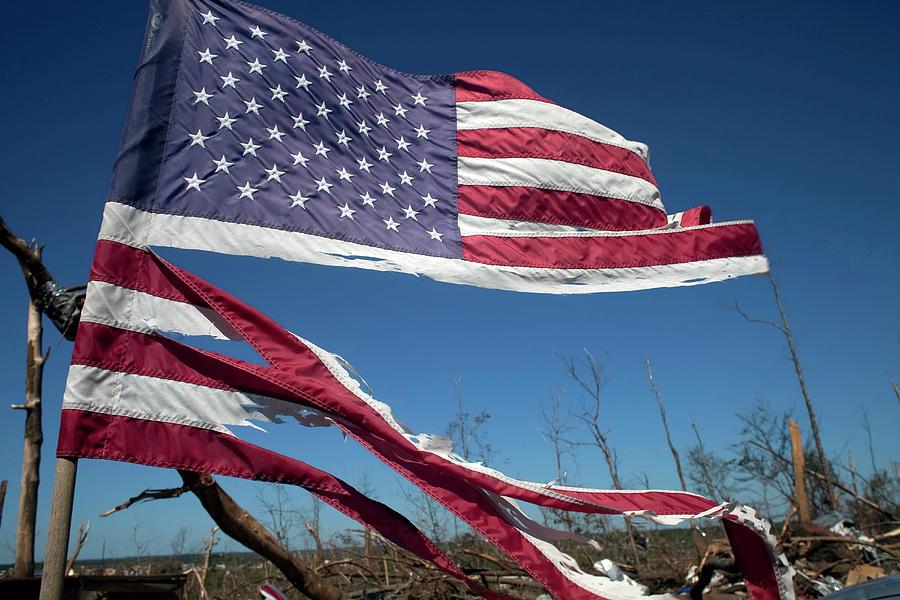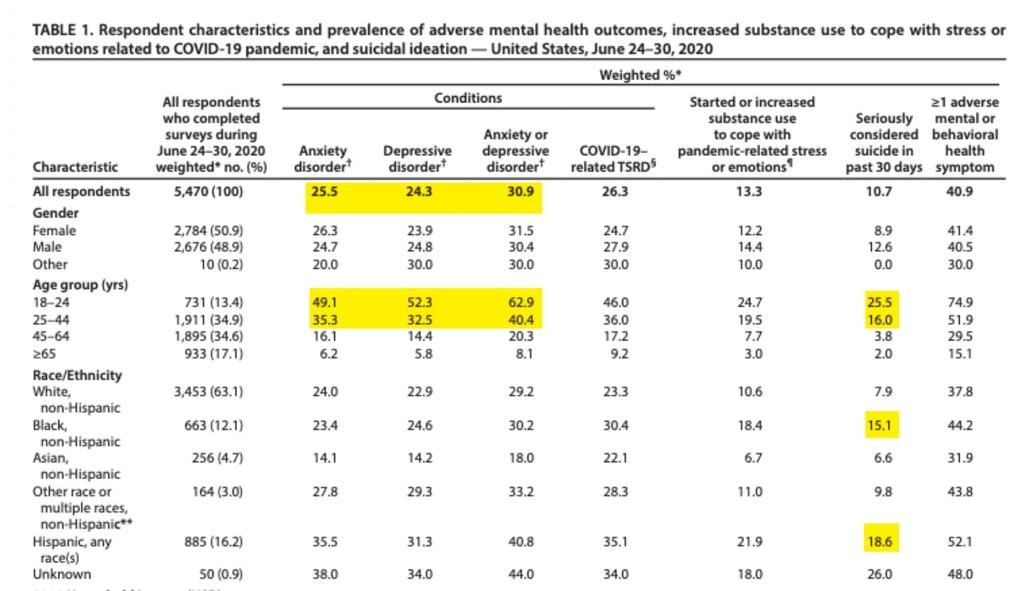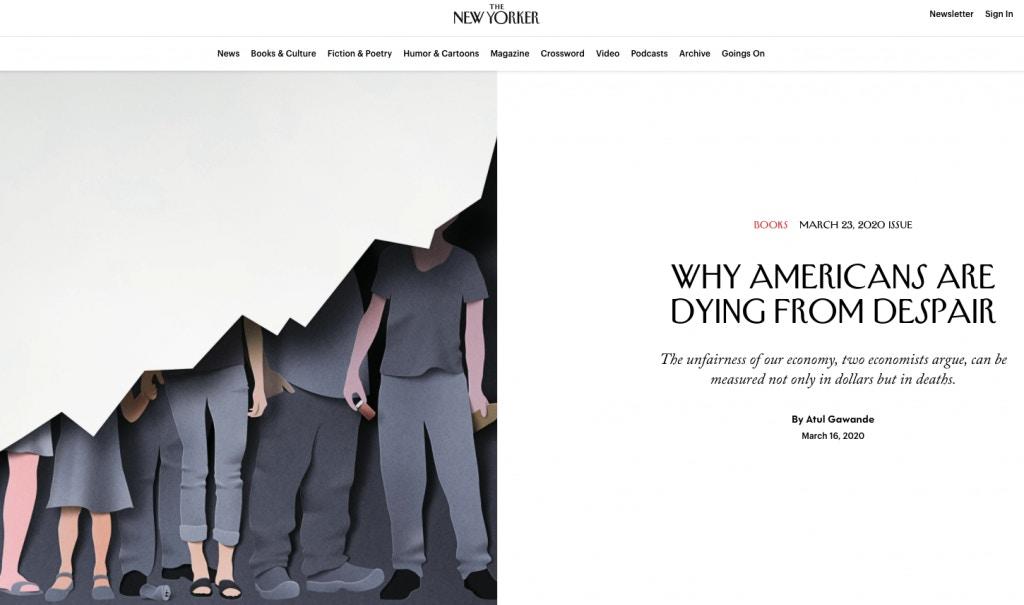Greenwald: America's Social Fabric Is Fraying Severely... If Not Unravelling Tyler Durden Sun, 08/30/2020 - 10:50
Authored by Glenn Greenwald via The Intercept,
Why, in the world’s richest country, is every metric of mental health pathology rapidly worsening?

THE YEAR 2020 has been one of the most tumultuous in modern American history. To find events remotely as destabilizing and transformative, one has to go back to the 2008 financial crisis and the 9/11 and anthrax attacks of 2001, though those systemic shocks, profound as they were, were isolated (one a national security crisis, the other a financial crisis) and thus more limited in scope than the multicrisis instability now shaping U.S. politics and culture.
Since the end of World War II, the only close competitor to the current moment is the multipronged unrest of the 1960s and early 1970s: serial assassinations of political leaders, mass civil rights and anti-war protests, sustained riots, fury over a heinous war in Indochina, and the resignation of a corruption-plagued president.
But those events unfolded and built upon one another over the course of a decade. By crucial contrast, the current confluence of crises, each of historic significance in their own right — a global pandemic, an economic and social shutdown, mass unemployment, an enduring protest movement provoking increasing levels of violence and volatility, and a presidential election centrally focused on one of the most divisive political figures the U.S. has known who happens to be the incumbent president — are happening simultaneously, having exploded one on top of the other in a matter of a few months.
Lurking beneath the headlines justifiably devoted to these major stories of 2020 are very troubling data that reflect intensifying pathologies in the U.S. population - not moral or allegorical sicknesses but mental, emotional, psychological and scientifically proven sickness. Many people fortunate enough to have survived this pandemic with their physical health intact know anecdotally — from observing others and themselves - that these political and social crises have spawned emotional difficulties and psychological challenges.
But the data are nonetheless stunning, in terms of both the depth of the social and mental health crises they demonstrate and the pervasiveness of them. Perhaps the most illustrative study was one released by the Centers for Disease Control and Prevention earlier this month, based on an extensive mental health survey of Americans in late June.
One question posed by researchers was whether someone has “seriously considered suicide in the past 30 days”— not fleetingly considered it as a momentary fantasy nor thought about it ever in their lifetime, but seriously considered suicide at least once in the past 30 days. The results are staggering.
For Americans between 18-24 years old, 25.5 percent — just over 1 out of every 4 young Americans — said they had. For the much larger group of Americans ages 25-44, the percentage was somewhat lower but still extremely alarming: 16 percent. A total of 18.6 percent of Hispanic Americans and 15 percent of African Americans said they had seriously considered suicide in the past month. The two groups with the largest percentage who said yes: Americans with less than a high school degree and unpaid caregivers, both of whom have 30 percent — or almost 1 out of every 3 — who answered in the affirmative. A full 10 percent of the U.S. population generally had seriously contemplated suicide in the month of June.
In a remotely healthy society, one that provides basic emotional needs to its population, suicide and serious suicidal ideation are rare events. It is anathema to the most basic human instinct: the will to live. A society in which such a vast swath of the population is seriously considering it as an option is one which is anything but healthy, one which is plainly failing to provide its citizens the basic necessities for a fulfilling life.
The alarming CDC data extends far beyond serious suicidal desires. It also found that “40.9% of respondents reported at least one adverse mental or behavioral health condition, including symptoms of anxiety disorder or depressive disorder (30.9%), symptoms of a trauma- and stressor-related disorder (TSRD) related to the pandemic (26.3%), and having started or increased substance use to cope with stress or emotions related to COVID-19 (13.3%).”
For the youngest part of the adult population, ages 18-24, significantly more than half (62.9 percent) reported suffering from depressive or anxiety disorders.

THAT MENTAL HEALTH WOULD SUFFER materially in the middle of a pandemic — one that requires isolation from community and work, quarantines, economic shutdowns, and fear of illness and death — is not surprising. In April, as the realities of isolation and quarantine were becoming more apparent in the U.S., we devoted a SYSTEM UPDATE episode to a discussion with the mental health experts Andrew Solomon and Johann Hari, both of whom described how “the traumas of this pandemic — the unraveling of our way of life for however long that lasts, the compulsory viewing of all other humans as threats, and especially sustained isolation and social distancing” — will exacerbate virtually every social pathology, including ones of mental health.
But what makes these trends all the more disturbing is that they long predated the arrival of the coronavirus crisis, to say nothing of the economic catastrophe left in its wake and the social unrest from this year’s protest movement. Indeed, since at least the financial crisis of 2008, when first the Bush administration and then the Obama administration acted to protect the interests of the tycoons who caused it while allowing everyone else to wallow in debt and foreclosures, the indicia of collective mental health in the U.S. have been blinking red.
In 2018, NBC News, using health insurance studies, reported that “major depression is on the rise among Americans from all age groups, but is rising fastest among teens and young adults.” In 2019, the American Psychological Association published a study documenting a 30 percent increase “in the rate of death by suicide in the United States between 2000 and 2016, from 10.4 to 13.5 per 100,000 people” and a 50 percent increase “in suicides among girls and women between 2000 and 2016.” It noted: “Suicide was the 10th-leading cause of death in the United States in 2016. It was the second-leading cause of death among people ages 10 to 34 and the fourth-leading cause among people ages 35 to 54.”
In March 2020, the New Yorker’s Atul Gawande published a survey of data from two Princeton economists, Anne Case and Angus Deaton, under the headline: “Why Americans Are Dying from Despair: the unfairness of our economy, two economists argue, can be measured not only in dollars but in deaths.” The decadeslong economic stagnation for Americans, the reversal of the American Dream, and the shockingly high mass unemployment ushered in by the pandemic are obviously significant reasons why these pathologies are rapidly worsening now.

Observing these trends is necessary but not sufficient for understanding their breadth and their impact. Why is virtually every metric of mental and spiritual disease — suicide, depression, anxiety disorders, addiction, and alcoholism — increasing significantly, rapidly, in the richest country on earth, one filled with advanced technologies and at least the pretense of liberal democracy?
One answer was provided by Dr. Laurel Williams, chief of psychiatry at Texas Children’s Hospital, to NBC when discussing the rise of depression:
“There’s a lack of community. There’s the amount of time that we spend in front of screens and not in front of other people. If you don’t have a community to reach out to, then your hopelessness doesn’t have any place to go.”
That answer is similar to the one offered by the brilliant book on depression and modern western societies by Johann Hari, “Lost Connections,” along with his viral TED Talk on the same topic: namely, it is precisely the attributes that define modern Western societies that are crafted perfectly to deprive humans of their most pressing emotional needs (a book by Hari on addiction, “Chasing the Scream,” and an even-more-viral TED Talk about it, sounds a similar theme about why Americans are turning in horrifyingly large numbers to serious problems of substance abuse).
Much attention is devoted to lamenting the toxicity of our discourse, the hate-driven polarization of our politics, and the fragmentation of our culture.
But it is difficult to imagine any other outcome in a society that is breeding so much psychological and emotional pathology by denying to its members the things they most need to live fulfilling lives.
Today’s SYSTEM UPDATE on The Intercept’s YouTube channel is devoted to exploring this unravelling of the social fabric: not just the data demonstrating that it is happening, but also what the causes are, and what the consequences are likely to be for our politics, our culture, our society generally. And the answers to the question prompted by all of this — where is the exit ramp to prevent these trends from worsening even further? — are as elusive as they are vital. It can also be viewed on the player below:
* * *
Join Our Newsletter Original reporting. Fearless journalism. Delivered to you. I’m in...
via IFTTT
InoreaderURL: SECONDARY LINK
